2006 SUBARU IMPREZA child restraint
[x] Cancel search: child restraintPage 66 of 365
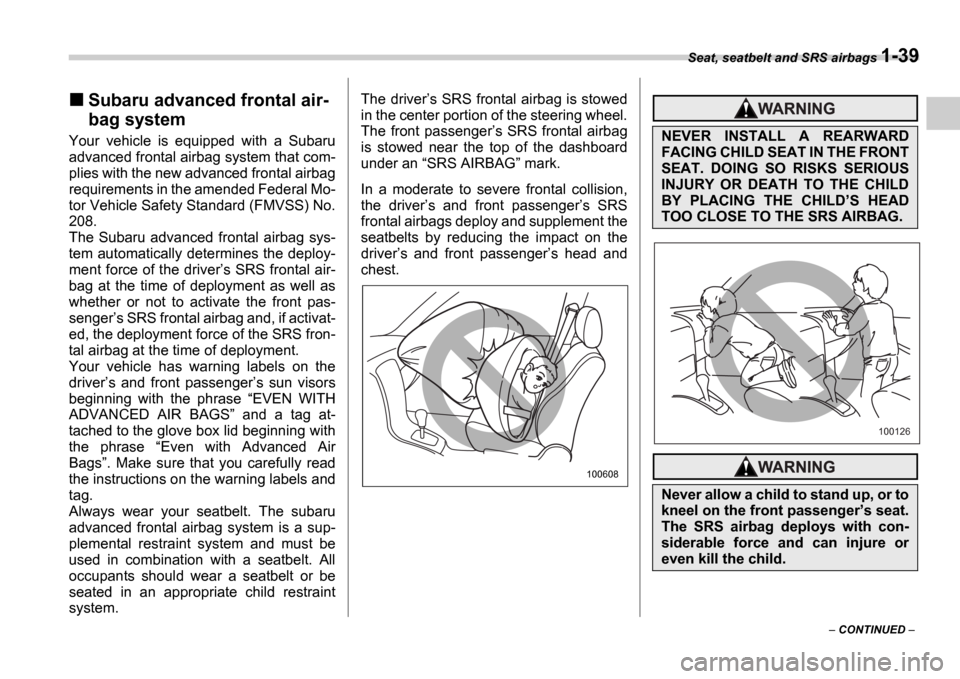
Seat, seatbelt and SRS airbags 1-39
CONTINUED
Subaru advanced frontal air-
bag system
Your vehicle is equipped with a Subaru
advanced frontal airbag system that com-
plies with the new advanced frontal airbag
requirements in the amended Federal Mo-
tor Vehicle Safety Standard (FMVSS) No.
208.
The Subaru advanced frontal airbag sys-
tem automatically determines the deploy-
ment force of the driver s SRS frontal air-
bag at the time of deployment as well as
whether or not to activate the front pas-
senger s SRS frontal airbag and, if activat-
ed, the deployment force of the SRS fron-
tal airbag at the time of deployment.
Your vehicle has warning labels on the
driver s and front passenger s sun visors
beginning with the phrase EVEN WITH
ADVANCED AIR BAGS and a tag at-
tached to the glove box lid beginning with
the phrase Even with Advanced Air
Bags . Make sure that you carefully read
the instructions on the warning labels and
tag.
Always wear your seatbelt. The subaru
advanced frontal airbag system is a sup-
plemental restraint system and must be
used in combination with a seatbelt. All
occupants should wear a seatbelt or be
seated in an appropriate child restraint
system. The driver
s SRS frontal airbag is stowed
in the center portion of the steering wheel.
The front passenger s SRS frontal airbag
is stowed near the top of the dashboard
under an SRS AIRBAG mark.
In a moderate to severe frontal collision,
the driver s and front passenger s SRS
frontal airbags deploy and supplement the
seatbelts by reducing the impact on the
driver s and front passenger s head and
chest.
100608
NEVER INSTALL A REARWARD
FACING CHILD SEAT IN THE FRONT
SEAT. DOING SO RISKS SERIOUS
INJURY OR DEATH TO THE CHILD
BY PLACING THE CHILD S HEAD
TOO CLOSE TO THE SRS AIRBAG.
Never allow a child to stand up, or to
kneel on the front passenger s seat.
The SRS airbag deploys with con-
siderable force and can injure or
even kill the child.
100126
Page 69 of 365
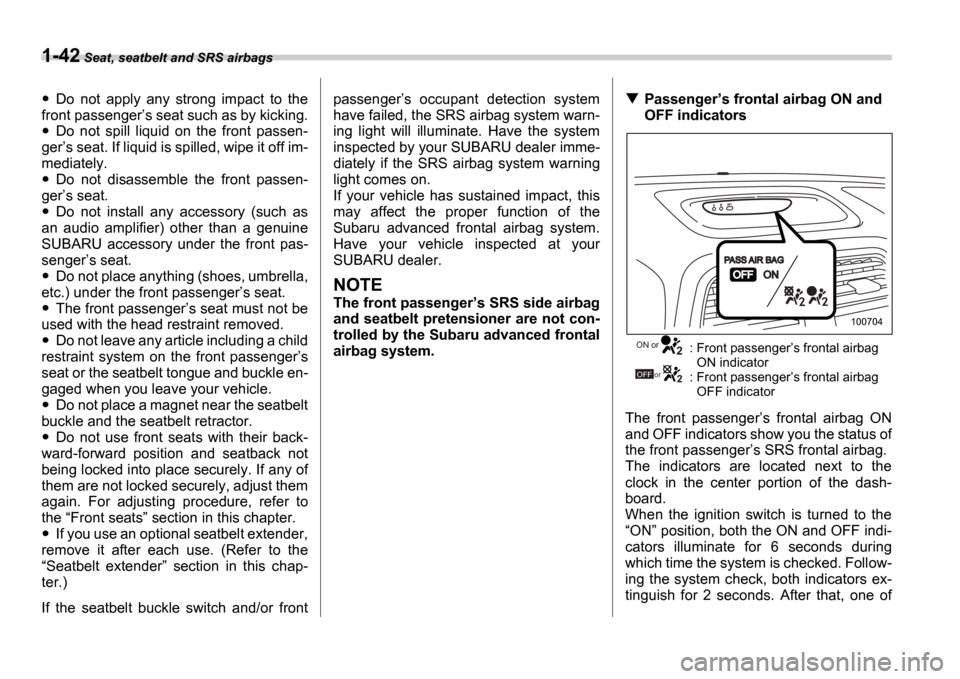
1-42 Seat, seatbelt and SRS airbags
Do not apply any strong impact to the
front passenger s seat such as by kicking.
Do not spill liquid on the front passen-
ger s seat. If liquid is spilled, wipe it off im-
mediately.
Do not disassemble the front passen-
ger s seat.
Do not install any accessory (such as
an audio amplifier) other than a genuine
SUBARU accessory under the front pas-
senger s seat.
Do not place anything (shoes, umbrella,
etc.) under the front passenger s seat.
The front passenger s seat must not be
used with the head restraint removed.
Do not leave any article including a child
restraint system on the front passenger s
seat or the seatbelt tongue and buckle en-
gaged when you leave your vehicle.
Do not place a magnet near the seatbelt
buckle and the seatbelt retractor.
Do not use front seats with their back-
ward-forward position and seatback not
being locked into place securely. If any of
them are not locked securely, adjust them
again. For adjusting procedure, refer to
the Front seats section in this chapter.
If you use an optional seatbelt extender,
remove it after each use. (Refer to the Seatbelt extender section in this chap-
ter.)
If the seatbelt buckle switch and/or front passenger
s occupant detection system
have failed, the SRS airbag system warn-
ing light will illuminate. Have the system
inspected by your SUBARU dealer imme-
diately if the SRS airbag system warning
light comes on.
If your vehicle has sustained impact, this
may affect the proper function of the
Subaru advanced frontal airbag system.
Have your vehicle inspected at your
SUBARU dealer.
NOTE
The front passenger s SRS side airbag
and seatbelt pretensioner are not con-
trolled by the Subaru advanced frontal
airbag system.
Passenger s frontal airbag ON and
OFF indicators
: Front passenger s frontal airbag
ON indicator
: Front passenger s frontal airbag
OFF indicator
The front passenger s frontal airbag ON
and OFF indicators show you the status of
the front passenger s SRS frontal airbag.
The indicators are located next to the
clock in the center portion of the dash-
board.
When the ignition switch is turned to the ON position, both the ON and OFF indi-
cators illuminate for 6 seconds during
which time the system is checked. Follow-
ing the system check, both indicators ex-
tinguish for 2 seconds. After that, one of
100704
ON or
OFF or
Page 70 of 365
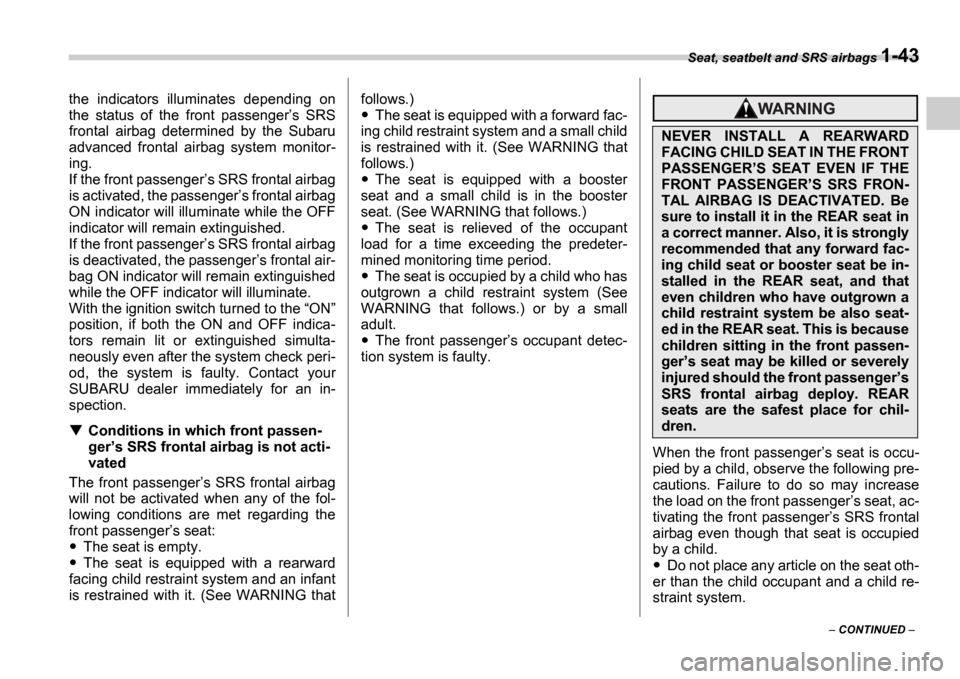
Seat, seatbelt and SRS airbags 1-43
CONTINUED
the indicators illuminates depending on
the status of the front passenger
s SRS
frontal airbag determined by the Subaru
advanced frontal airbag system monitor-
ing.
If the front passenger s SRS frontal airbag
is activated, the passenger s frontal airbag
ON indicator will illuminate while the OFF
indicator will remain extinguished.
If the front passenger s SRS frontal airbag
is deactivated, the passenger s frontal air-
bag ON indicator will remain extinguished
while the OFF indicator will illuminate.
With the ignition switch turned to the ON
position, if both the ON and OFF indica-
tors remain lit or extinguished simulta-
neously even after the system check peri-
od, the system is faulty. Contact your
SUBARU dealer immediately for an in-
spection.
Conditions in which front passen-
ger s SRS frontal airbag is not acti-
vated
The front passenger s SRS frontal airbag
will not be activated when any of the fol-
lowing conditions are met regarding the
front passenger s seat:
The seat is empty.
The seat is equipped with a rearward
facing child restraint system and an infant
is restrained with it. (See WARNING that follows.)
The seat is equipped with a forward fac-
ing child restraint system and a small child
is restrained with it. (See WARNING that
follows.)
The seat is equipped with a booster
seat and a small child is in the booster
seat. (See WARNING that follows.)
The seat is relieved of the occupant
load for a time exceeding the predeter-
mined monitoring time period.
The seat is occupied by a child who has
outgrown a child restraint system (See
WARNING that follows.) or by a small
adult.
The front passenger s occupant detec-
tion system is faulty.
When the front passenger s seat is occu-
pied by a child, observe the following pre-
cautions. Failure to do so may increase
the load on the front passenger s seat, ac-
tivating the front passenger s SRS frontal
airbag even though that seat is occupied
by a child.
Do not place any article on the seat oth-
er than the child occupant and a child re-
straint system.
NEVER INSTALL A REARWARD
FACING CHILD SEAT IN THE FRONT
PASSENGER S SEAT EVEN IF THE
FRONT PASSENGER S SRS FRON-
TAL AIRBAG IS DEACTIVATED. Be
sure to install it in the REAR seat in
a correct manner. Also, it is strongly
recommended that any forward fac-
ing child seat or booster seat be in-
stalled in the REAR seat, and that
even children who have outgrown a
child restraint system be also seat-
ed in the REAR seat. This is because
children sitting in the front passen-
ger s seat may be killed or severely
injured should the front passenger s
SRS frontal airbag deploy. REAR
seats are the safest place for chil-
dren.
Page 71 of 365

1-44 Seat, seatbelt and SRS airbags
Do not place more than one child on the
seat.
Do not install any accessory such as a
table or TV onto the seatback.
Do not store a heavy load in the seat-
back pocket.
Do not allow the rear seat occupant to
place his/her hands or legs on the front
passenger s seatback, or allow him/her to
pull the seatback.
If the front passenger s frontal air-
bag ON indicator illuminates and the
OFF indicator extinguishes even
when an infant or a small child is in
a child restraint system (including
booster seat)
Turn the ignition switch to the OFF posi-
tion if the front passenger s frontal airbag
ON indicator illuminates and the OFF indi-
cator extinguishes even when an infant or
a small child is in a child restraint system
(including booster seat). Remove the child
restraint system from the seat. By refer-
ring to the child restraint manufacturer s
recommendations as well as the child re-
straint system installation procedures in
the Seat heater (if equipped) section in
this chapter, correctly install the child re-
straint system. Turn the ignition switch to
the ON position and make sure that the
front passenger s frontal airbag ON indi- cator goes out and the OFF indicator
comes on.
If still the ON indicator remains illuminated
while the OFF indicator extinguishes, take
the following actions.
Ensure that no article is placed on the
seat other than the child restraint system
and the child occupant.
Ensure that there is no article left in the
seatback pocket.
Ensure that the backward-forward posi-
tion and seatback of front passenger s
seat are locked into place securely by
moving the seat back and forth.
If the ON indicator still illuminates while
the OFF indicator extinguishes after tak-
ing relevant corrective actions described
above, relocate the child restraint system
to the rear seat and immediately contact
your SUBARU dealer for an inspection.
NOTE
When a child who has outgrown a child
restraint system or a small adult is
seated in the front passenger s seat,
the Subaru advanced frontal airbag
system may or may not activate the
front passenger s SRS frontal airbag
depending on the occupant s seating
posture. If the front passenger s SRS
frontal airbag is activated (the ON indi- cator illuminates while the OFF indica-
tor extinguishes), take the following
actions.
Ensure that no article is placed on
the seat other than the occupant.
Ensure that there is no article left in
the seatback pocket.
If the ON indicator still illuminates
while the OFF indicator extinguishes
despite the fact that the actions noted
above have been taken, seat the child/
small adult in the rear seat and immedi-
ately contact your SUBARU dealer for
an inspection. Even if the system has
passed the dealer inspection, it is rec-
ommended that on subsequent trips
the child/small adult always take the
rear seat.
Children who have outgrown a child re-
straint system should always wear the
seatbelt irrespective of whether the airbag
is deactivated or activated.
Conditions in which front passen-
ger s SRS frontal airbag is activated
The front passenger s SRS frontal airbag
will be activated for deployment upon im-
pact when any of the following conditions
is met regarding the front passenger s
seat.
When the seat is occupied by an adult.
Page 92 of 365
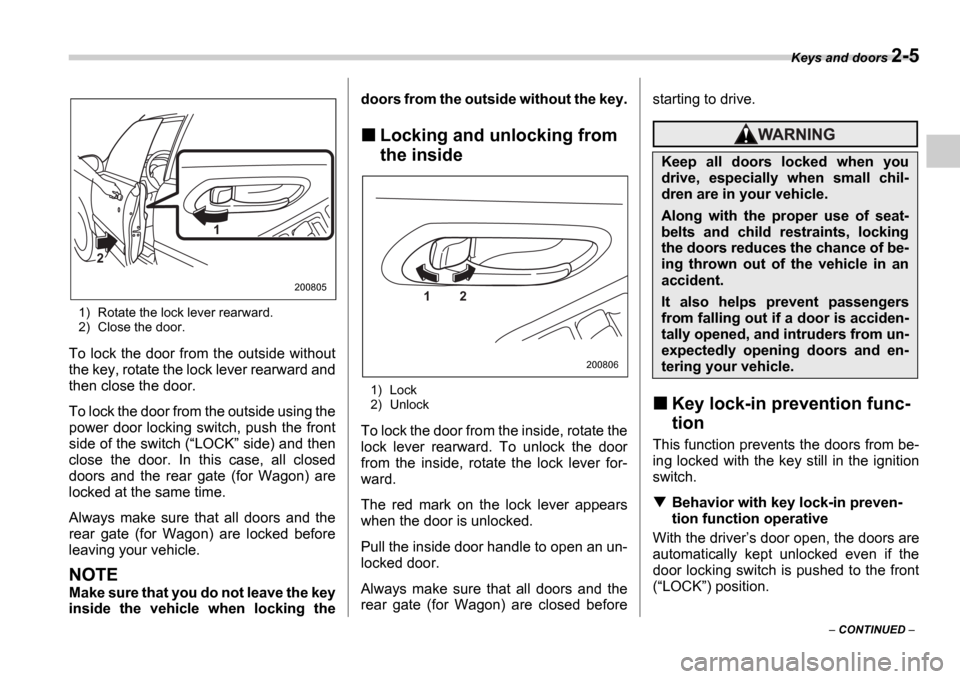
Keys and doors 2-5
CONTINUED
1) Rotate the lock lever rearward.
2) Close the door.
To lock the door from the outside without
the key, rotate the lock lever rearward and
then close the door.
To lock the door from the outside using the
power door locking switch, push the front
side of the switch ( LOCK side) and then
close the door. In this case, all closed
doors and the rear gate (for Wagon) are
locked at the same time.
Always make sure that all doors and the
rear gate (for Wagon) are locked before
leaving your vehicle.
NOTE
Make sure that you do not leave the key
inside the vehicle when locking the doors from the outside without the key.
Locking and unlocking from
the inside
1) Lock
2) Unlock
To lock the door from the inside, rotate the
lock lever rearward. To unlock the door
from the inside, rotate the lock lever for-
ward.
The red mark on the lock lever appears
when the door is unlocked.
Pull the inside door handle to open an un-
locked door.
Always make sure that all doors and the
rear gate (for Wagon) are closed before starting to drive.
Key lock-in prevention func-
tion
This function prevents the doors from be-
ing locked with the key still in the ignition
switch.
Behavior with key lock-in preven-
tion function operative
With the driver s door open, the doors are
automatically kept unlocked even if the
door locking switch is pushed to the front( LOCK ) position.
1
2
2008051 2
200806
Keep all doors locked when you
drive, especially when small chil-
dren are in your vehicle.
Along with the proper use of seat-
belts and child restraints, locking
the doors reduces the chance of be-
ing thrown out of the vehicle in an
accident.
It also helps prevent passengers
from falling out if a door is acciden-
tally opened, and intruders from un-
expectedly opening doors and en-
tering your vehicle.
Page 351 of 365
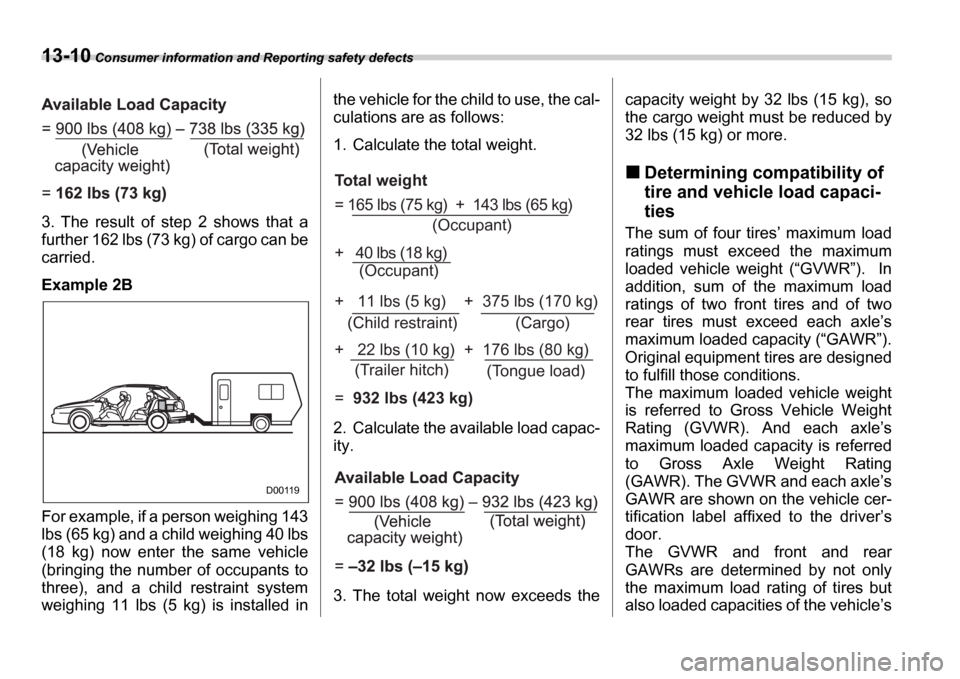
13-10 Consumer information and Reporting safety defects
3. The result of step 2 shows that a
further 162 lbs (73 kg) of cargo can be
carried.
Example 2B
For example, if a person weighing 143
lbs (65 kg) and a child weighing 40 lbs
(18 kg) now enter the same vehicle
(bringing the number of occupants to
three), and a child restraint system
weighing 11 lbs (5 kg) is installed in the vehicle for the child to use, the cal-
culations are as follows:
1. Calculate the total weight.
2. Calculate the available load capac-
ity.
3. The total weight now exceeds the
capacity weight by 32 lbs (15 kg), so
the cargo weight must be reduced by
32 lbs (15 kg) or more.
Determining compatibility of
tire and vehicle load capaci-
ties
The sum of four tires
maximum load
ratings must exceed the maximum
loaded vehicle weight ( GVWR ). In
addition, sum of the maximum load
ratings of two front tires and of two
rear tires must exceed each axle s
maximum loaded capacity ( GAWR ).
Original equipment tires are designed
to fulfill those conditions.
The maximum loaded vehicle weight
is referred to Gross Vehicle Weight
Rating (GVWR). And each axle s
maximum loaded capacity is referred
to Gross Axle Weight Rating
(GAWR). The GVWR and each axle s
GAWR are shown on the vehicle cer-
tification label affixed to the driver s
door.
The GVWR and front and rear
GAWRs are determined by not only
the maximum load rating of tires but
also loaded capacities of the vehicle s
D00119
Page 358 of 365

Index 14-3
Oil and oil filter ................................ ............................. 11-8
Charge warning light .............................. .......................... 3-16
CHECK ENGINE warning light/Malfunction indicator lamp .............................................. ................................ 3-16
Checking Brake pedal free play ............................... .................. 11-27
Brake pedal reserve distance ........................... ......... 11-27
Clutch function ..................................... ...................... 11-28
Clutch pedal free play .............................. .................. 11-28
Engine oil level ................................... ......................... 11-8
Fluid level ................................. 11-20 , 11-24, 11-25, 11-26
Gear oil level ..................................... ... 11-18, 11-21, 11-22
Child restraint systems ............................... ...................... 1-23
Installation with A/ELR seatbelt ................... ................ 1-26
Lower and tether anchorages ........................ .............. 1-30
Child safety ........................................ .................................... 5
Locks ................................................ ........................... 2-18
Chime Key ................................................ ................................ 3-5
Seatbelt .......................................... .................... 1-11, 3-14
Cigarette lighter socket ............................ ........................... 6-6
Cleaning Aluminum wheels .................................... .................... 10-3
Interior .......................................... ............................... 10-5
Ventilator grille ................................. ............................ 4-11
Climate control system Automatic ......................................... .............................. 4-7
Manual ............................................ ............................... 4-3
Clock ............................................... ................................. 3-22
Clutch fluid ....................................... ............................... 11-26
Clutch pedal ....................................... ............................ 11-28
Coat hook .......................................... ................................. 6-9Coin tray ..........................................
................................... 6-4
Cooling system ....................................... ........................ 11-12
Corrosion protection ................................ ................ 8-10, 10-4
Cruise control ...................................... .............................. 7-27
Indicator light .................................... ............................ 3-20
Set indicator light ................................ ......................... 3-20
Cup holder ........................................ .................................. 6-5
D
Daytime running light system ......................... ................... 3-23
Differential gear oil Front ............................................. .............................. 11-21
Rear .............................................. ............................. 11-22
Dimensions .......................................... ............................. 12-2
Disarming the system ................................. ...................... 2-15
Disc brake pad wear warning indicators ................ ........... 7-22
Dome light ........................................ ........................ 6-2, 11-50
Door locks ......................................... .................................. 2-4
Door open warning light ........................... ......................... 3-19
Drive belts ........................................ ............................... 11-18
Driver s control center differential ....................... .............. 7-12
Drivers control center differential Auto indicator light ............................... ........................ 3-20
Indicator lights .................................... .......................... 3-21
Driving Car phone/cell phone ............................... ......................... 7
Drinking ........................................... .................................. 6
Drugs .............................................. .................................. 7
Foreign countries ................................... ........................ 8-4
Pets ............................................... .................................... 7
Snowy and icy roads ................................... ................... 8-9
Tips ............................................... .............. 7-10, 7-12, 8-5